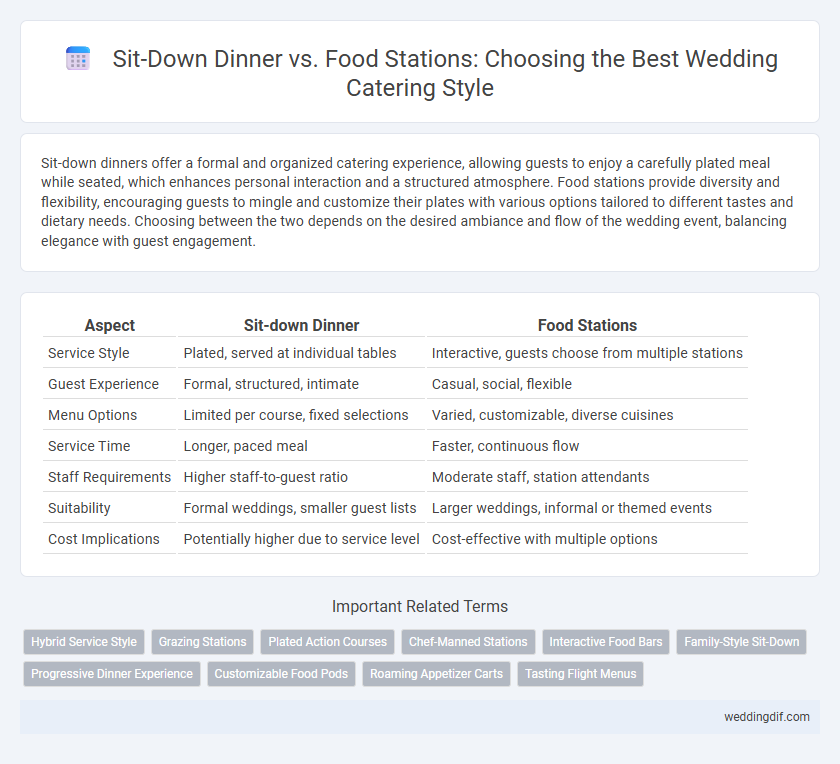Sit-down dinners offer a formal and organized catering experience, allowing guests to enjoy a carefully plated meal while seated, which enhances personal interaction and a structured atmosphere. Food stations provide diversity and flexibility, encouraging guests to mingle and customize their plates with various options tailored to different tastes and dietary needs. Choosing between the two depends on the desired ambiance and flow of the wedding event, balancing elegance with guest engagement.
Table of Comparison
| Aspect | Sit-down Dinner | Food Stations |
|---|---|---|
| Service Style | Plated, served at individual tables | Interactive, guests choose from multiple stations |
| Guest Experience | Formal, structured, intimate | Casual, social, flexible |
| Menu Options | Limited per course, fixed selections | Varied, customizable, diverse cuisines |
| Service Time | Longer, paced meal | Faster, continuous flow |
| Staff Requirements | Higher staff-to-guest ratio | Moderate staff, station attendants |
| Suitability | Formal weddings, smaller guest lists | Larger weddings, informal or themed events |
| Cost Implications | Potentially higher due to service level | Cost-effective with multiple options |
Introduction to Sit-Down Dinner vs Food Stations
Sit-down dinners for wedding catering offer a formal dining experience with plated courses served individually to guests, emphasizing elegance and structured service. Food stations provide a more interactive and flexible option, allowing guests to choose from a variety of freshly prepared dishes in a buffet-style setting that encourages mingling. Both styles cater to different guest preferences and event atmospheres, with sit-down dinners favoring tradition and food stations promoting variety and social engagement.
Key Differences Between Sit-Down Dinners and Food Stations
Sit-down dinners provide a formal dining experience with plated courses served to guests at assigned seats, promoting structured meal pacing and personalized service. Food stations offer a more interactive and casual atmosphere, allowing guests to choose from a variety of dishes presented at different themed areas, encouraging mingling and flexibility in dining. Key differences include the level of formality, guest mobility, and the style of service--traditional and controlled versus dynamic and self-directed.
Guest Experience: Formality and Interaction
Sit-down dinners offer a formal dining experience where guests enjoy personalized service and a structured meal sequence, enhancing elegance and traditional ambiance. Food stations encourage mingling and interaction, allowing guests to customize their plates and engage with chefs, fostering a lively and social atmosphere. Choosing between the two depends on the desired level of formality and the importance of guest interaction during the wedding reception.
Menu Variety and Customization Options
Sit-down dinner service offers a structured menu with limited variety, typically featuring a fixed number of courses pre-selected by the couple, ensuring consistency and ease of planning. Food stations provide extensive menu variety and customization options, allowing guests to personalize their meals with diverse cuisines, ingredients, and dietary accommodations. This flexibility in food stations caters to diverse taste preferences and enhances guest interaction, making it ideal for couples prioritizing diverse culinary experiences.
Cost Considerations for Both Catering Styles
Sit-down dinners for wedding catering typically involve higher costs due to extensive staffing and plated meal services, whereas food stations offer more flexibility and often lower labor expenses by allowing guests to serve themselves. Buffet-style food stations can reduce overall catering costs by minimizing the need for servers and enabling bulk preparation, but may increase expenses if a wide variety of stations and gourmet options are offered. Budget-conscious couples should evaluate guest count, menu complexity, and service level when comparing the cost efficiency of these catering styles for their wedding.
Service Flow and Timing at the Reception
Sit-down dinners offer a structured service flow with courses served sequentially, ensuring predictable timing and formal pacing that suits traditional wedding receptions. Food stations provide a dynamic and flexible timing arrangement, allowing guests to move at their own pace and encouraging social interaction, which can reduce bottlenecks during peak serving times. Efficient coordination and staffing are crucial in both setups to maintain smooth service flow and ensure timely meal delivery during the wedding reception.
Space Requirements and Venue Layout
Sit-down dinners require a spacious dining area with carefully arranged seating to accommodate guests comfortably, often necessitating larger venues or open floor plans. Food stations demand flexible layout options, emphasizing flow and accessibility to prevent congestion while allowing guests to mingle and move freely. Venue layouts with expansive floor space and multiple entry points optimize food station setups, whereas formal dining rooms better suit sit-down dinners.
Dietary Accommodations and Flexibility
Sit-down dinners offer precise control over dietary accommodations, allowing caterers to prepare customized meals for guests with specific dietary restrictions such as gluten-free or vegan options. Food stations provide greater flexibility by enabling guests to choose from a variety of dishes that cater to diverse preferences and allergies, promoting an inclusive dining experience. Both options require clear communication with the catering team to ensure all dietary needs are met effectively during the wedding event.
Pros and Cons of Sit-Down Dinner Catering
Sit-down dinner catering offers a formal and elegant dining experience, allowing guests to enjoy plated courses with personalized service, which enhances the overall ambiance of a wedding. It promotes social interaction at the table and ensures portion control, reducing food waste, but can be more costly and time-consuming due to the need for extensive staffing and coordination. Limited menu options and slower serving times may also reduce guest mobility and variety compared to more casual formats like food stations.
Pros and Cons of Food Stations at Weddings
Food stations at weddings offer a dynamic and interactive dining experience, allowing guests to customize their meals and sample a variety of cuisines, which enhances guest satisfaction and dietary accommodation. They can reduce wait times and promote social mingling, but may require more space and logistical coordination compared to traditional sit-down dinners. Challenges include potential crowding at popular stations and difficulties in maintaining food temperature and quality throughout the event.
Sit-down dinner vs Food Stations for wedding catering Infographic

 weddingdif.com
weddingdif.com